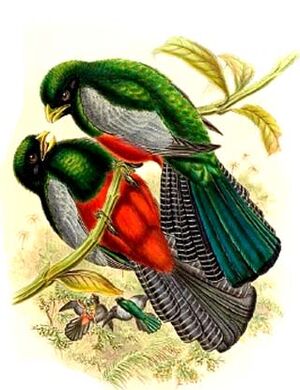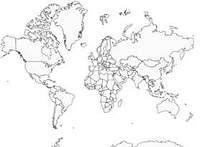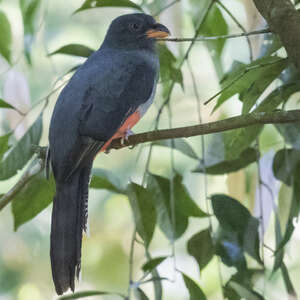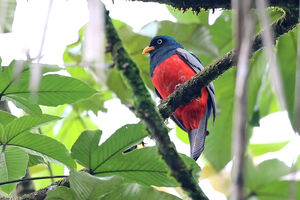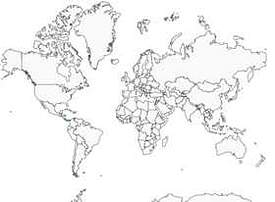Lattice-tailed Trogon
Trogon clathratus - Trogon échelette
Identification
Here and generally, we only know the Lattice-tailed Shrike, but there is also the Lattice-tailed Trogon (Trogon clathratus) whose literal Latin translation could be "latticed", referring to its tail with very fine stripes. The Anglophones call it the Lattice-tailed Trogon or the Trellised-tailed Trogon. It has the average size of Trogons, 28 cm and pronounced dimorphism. The Lattice-tailed Trogon has a striking feature: its white iris surrounded by a black pupil that will help differentiate it from its close cousins, the Massena Trogon and the Black-tailed Trogon that have overlapping distributions. The beak is yellow surrounded by black bristles, grayish-black parotic regions in contrast to the emerald-green crown, mantle, back and scapulars; the coverts and secondary remiges show horizontally wavy black and white; the tertiary remiges are black with white margins. The chest is of the same emerald-green of the back, sometimes with a tendency to darken in the light, while the belly and lower belly are bright red leading to the lower rectrices that are black striped with very thin white lines, the distinctive element of the Lattice-tailed Trogon. The superior rectrices are blue-green with a slightly electric hue. On the female all is different, the parotics are more sooty-black than black, the culmen black and the lower mandible still yellow (the female of Massena Trogon has an orange-red beak), the crown, mantle and back are gray, the top of the chest also gray to slowly transition to a light brown, the belly is red but duller than the male. The coverts do not show the same contrast as the male, but rather thin wavy lines on a grayish dark brown background.The tail is identical, maybe a little less striped on the central lower retrices. The tarses are light brown. Juveniles are closer to their mother, with a light brown dominant instead of the adult female's gray, the belly and chest have a more reddish hue, the cover markings start to show horizontal waves but on a brown background. The Lattice-tailed Trogon, depending on the lighting conditions and its attitude, can be mistaken for Massena's Trogon, Black-tailed Trogon and White-eyed Trogon.
Subspecific information monotypic species
Foreign names
- Trogon échelette,
- Trogón colibarrado,
- surucuá-de-olho-branco,
- Sperberschwanztrogon,
- Rasterstaarttrogon,
- Trogone reticolato,
- costaricatrogon,
- Netthaletrogon,
- trogón mriežkochvostý,
- trogon ozdobný,
- Gitterhalet Trogon,
- keltasilmätrogoni,
- trogon de cua enreixada,
- trogon kostarykański,
- Ястребинохвостый трогон,
- シマオグロキヌバネドリ,
- 花尾美洲咬鹃,
- costaricatrogon,
- 格尾美洲咬鵑,
Voice song and call
Habitat
The Lattice-tailed Trogon is confined to low and medium canopies, between heights of 20 and 40m and the lower foothills of the Central Cordillera of Costa Rica. It can occasionally be spotted at the edge of sparse forests, but such observations are rare. West of Panama, it is consistently encountered in humid environments up to 1000m above sea level. Its habitat is actually very similar to that of the Massena's Trogon, but it seems to be less adaptable and more fragile, which limits its spread.
Behaviour character trait
Resident in Costa Rica, it is known that the Lattice-tailed Trogon descends after the breeding season.
Dietfeeding habits
The Lattice-tailed Trogon enjoys Lauraceae like the Persea americana variety which gives us the avocado. It will seek out various fruits but is also an insectivore. It is thought to be an opportunist and, at times, will hunt for small amphibians and lizards.
Reproduction nesting
The breeding season runs from February to May, Lattice-tailed Trogon courtship with the female is similar to that of other Trogons such as the Massena Trogon. American ornithologist Paul Slud (1919-2006) observed both sexes making sharp, high pitched cries while raising their tails, at the same time the male crosses its outer rectrices and will thus obscure the central rectrices. The nest is often made in an excavation of an old tree or in an arboreal termite nest at a height of 5 to 8 m. Unfortunately, there is no information on the number of eggs, incubation period and raising of the young.
Geographic range
Threats - protection
IUCN conservation status
concern
in the Wild
threatened
evaluated
The Lattice-tailed Trogon does not seem to be in danger, but the bird is seldom observed and its range is limited to two countries: Costa Rica and Panama. Therefore, it is up to us humans to be responsible so that the Lattice-tailed Trogon can continue to flaunt its beauty!
Sources of information
- IOC World Bird List (v14.2), Gill, F and D Donsker (Eds). 2024-04-18.
- A Natural history of the Trogonidae, Joseph M.Forshaw Albert Earl Gilbert
- The Birds of Panama, George R.Anger Robert Dean
- Vol. 6 - Handbook of the Birds of the World, Josep del Hoyo-Andrew Elliott-Jordi Sargatal
- xeno-canto, Sharing bird sounds from around the world,
- Arthur Grosset's Birds, Arthur Grosset
- Avibase, Lepage Denis
- Planet of Birds,
- Wikipédia, Wikipedia, The Free Encyclopedia
- BirdLife International, BirdLife International
Other sources of interest
 Specification sheet created on
02/08/2023 by Anne et Gabriel Leboff
Specification sheet created on
02/08/2023 by Anne et Gabriel LeboffTranslation by AI Oiseaux.net
© 1996-2025 Oiseaux.net
- Accipitriformes
- Aegotheliformes
- Anseriformes
- Apodiformes
- Apterygiformes
- Bucerotiformes
- Caprimulgiformes
- Cariamiformes
- Casuariiformes
- Charadriiformes
- Ciconiiformes
- Coliiformes
- Columbiformes
- Coraciiformes
- Cuculiformes
- Eurypygiformes
- Falconiformes
- Galliformes
- Gaviiformes
- Gruiformes
- Leptosomiformes
- Mesitornithiformes
- Musophagiformes
- Nyctibiiformes
- Opisthocomiformes
- Otidiformes
- Passeriformes
- Pelecaniformes
- Phaethontiformes
- Phoenicopteriformes
- Piciformes
- Podargiformes
- Podicipediformes
- Procellariiformes
- Psittaciformes
- Pterocliformes
- Rheiformes
- Sphenisciformes
- Steatornithiformes
- Strigiformes
- Struthioniformes
- Suliformes
- Tinamiformes
- Trogoniformes

